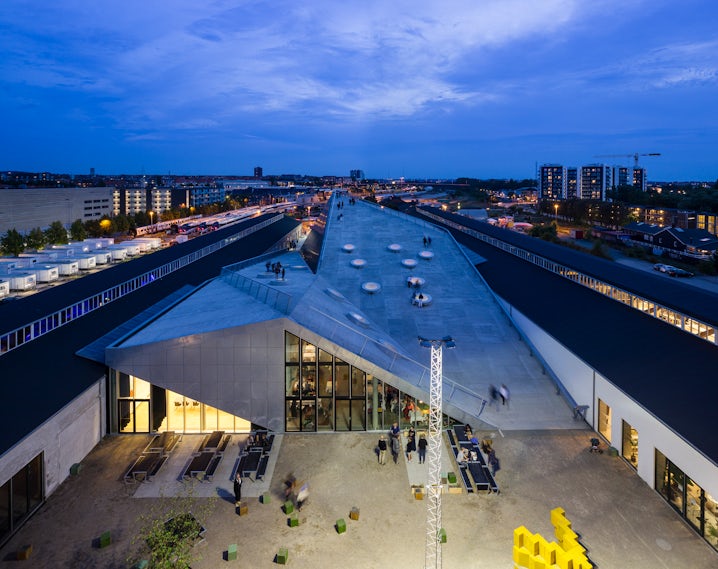The fourth annual Architizer A+Awards program is now open for entries! Help us celebrate great architecture and get your designs recognized on a global stage: FIND OUT HOW TO SUBMIT YOUR PROJECT, HERE.
To celebrate the launch of this year’s A+Awards — the world’s largest awards program for architecture and products — we asked the winners from 2015 about the secrets behind their success, the exciting new projects on their drawing boards, and their personal architectural inspirations. Up this week, it’s Professor Eckhard Gerber of Gerber Architekten, winner of the jury vote in the Architecture +Materials category for the innovative façade of the King Fahad National Library in Riyadh, Saudi Arabia.

Architizer: What was it about your winning project that you think resonated most with voters?
Prof. Eckhard Gerber: I think our draft for the King Fahad National Library particularly convinced the jury as we specifically developed an ornamental cladding composed of rhomboidal textile awnings, which is characterized by its play with revealing and concealing.
The fixed white membrane surfaces act as a sunshade and interpret the Arabic tradition of tent structures in a technologically modern manner. Our ashlar-shaped structure enveloped by textile awnings is fitted around the existing old building and is connected to it in an unusual way according to monument preservation principles.

A: Since winning your A+Award, what’s the most exciting project that you have been working on?
EG: Every project brings with it its own individual challenges with its own specifications. In every project, we occupy ourselves with the specific nature of the area, its history, topography, and the surrounding structures. Our building and urban landscape ensembles, which come into being in this way, should reflect the genius loci as uniques in order to shape a striking and memorable idea of the building and the space within the context of all partial aspects. That is where the appeal of every project lies.

A: Which of this year’s A+Awards jurors do you find most compelling, and why?
EG: The jury of the A+Awards is composed of so many interesting personalities from the fields of architecture, design, and theatre, from the property sector, as well as from the industry or the public administration, which makes it challenging for me to single out one person among the 300.

A: Among your fellow A+Award winners, which project is your favorite, and why?
EG: One World Trade Center impressed me with the shape of the building and its expression. A highly expressive volume was created from the simple original form of two differently sized squares. Standing at the bottom of the building and looking upwards, a pyramid appears, which seems to infinitely extend itself into the sky.
Observed form a distance, the triangular façade surfaces arising from the square surfaces intertwine and, in doing so, mirror the ground on the one hand, and the sky on the other, and cause them to merge together. An impressive sight considering the event that occurred at that location.

A: Who’s your design hero and/or favorite building, and why?
EG: Alvar Aalto has always particularly impressed and fascinated me with his buildings. They have been developed naturally and simply and are poetic in their ground and elevation plans, but also in the choice of materials. Alvar Aalto understood developing buildings, which, on the one hand, prominently rise up from the landscape but still seem to blend into the landscape at the same time. Similarly to his architecture, I also value his contributions to the design of the 20th century — his vase with its flowing, organic shape — a design classic!

A: What do you find exciting about architecture and design right now?
EG: Throughout the last centuries, architecture has become very multilingual. New building materials and matter enable a myriad of architectural languages and shapes. From a technical standpoint, buildings can also cater to specific requirements in their design. Energetic-ecological aspects are only one of many.
Of course, the continuation of traditional modes of construction should not be disregarded in the process. In this respect, there is not one striking architecture from our zeitgeist, but various differing ones with various solutions.

A: Which city would you most like to visit next for its architecture?
EG: As well as all large cities where top-class architecture is constantly created and where architectural classics are present, such as the Seagram Building by Ludwig Mies van der Rohe, I also have interest for the Brazilian capital city, Brasília. Brasília is an example of one city that architects designed in its entirety. As head of the state construction authority and as an architect, Oscar Niemeyer was responsible for all the public buildings, and a ground plan in the shape of a cross with a curved axis was chosen for the city.

A: Which material do you most love designing with and why?
EG: We see an opportunity for the development of architecture, which suits every respective area and its history, in all materials! Constructive and functional thoughts also flow into it — as well as the assignment of the client or thoughts with regard to which materials are best suitable from a regional standpoint. In this respect, there is no one particular material we prefer to work with.
Only glass, which enables the opening of a building, would be singled out as a material. It allows the creation of visual connections, which serve the orientation within the building as well as in the urban space. Directed views can also be created. Connections of the interior with the scenic exterior are an additional important aspect in our architectural language.




